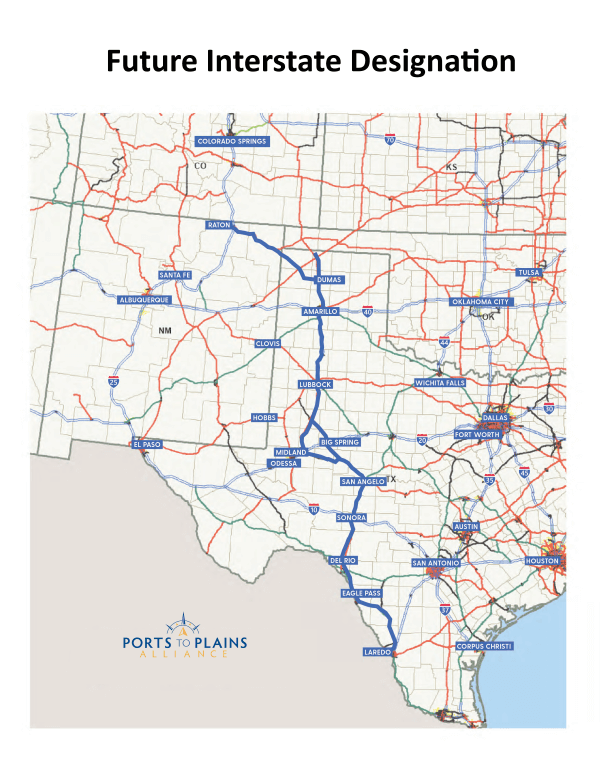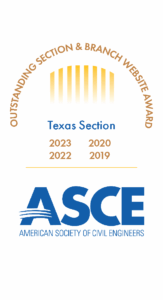Building an Interstate in West Texas
Author: Lauren D. Garduño PE, MASCE
January 2025

I. Introduction
On September 26, 2024, the Texas Transportation Commission adopted a minute order that extended the existing Interstate Highway 27 by 4.2 miles south of Lubbock Texas. This action was the culmination of six years of a collaborative effort between TxDOT, its consultants, and the Ports-to-Plains Alliance. This event also demonstrated the value of having the political will to bring about such a herculean effort to build an interstate system, not just in Texas, but anywhere in the United States. Without the support of state and federal legislators, this project is dead in the water. But why is this the case? You have to go back to the history of the Interstate System to find clues as to the answer to that question.
II. History of the Interstate including Texas
In 1956, President Eisenhower signed the Interstate Highway Act. The country’s transportation system outside of the rail network was evolving. As far back as the late thirties’ states were developing and improving their transportation networks to pre-interstate standards. These new highways were called turnpikes and relied upon toll revenues to finance and build. One of the first examples was the Pennsylvania Turnpike. Coming out of World War II, then General Eisenhower recognized the value of having a strategic military transportation system to move armament across the country. In fact, during the war, efforts were underway to expand the Great Alaska Highway for that very purpose. By the time we reached the fifties, some states were moving forward with turnpike systems of their own as they explored ways to finance and build out their network. In Texas, our first attempt was the Dallas/Fort Worth Turnpike (Present day IH 30) or depending on where you were from the Fort Worth/Dallas Turnpike. The debate on Capitol Hill centered on how to fund a future interstate highway system. Again, we see an example of the power of political will in driving a major infrastructure program to a successful outcome. Advocacy groups such as the U. S. Conference of Mayors, the American Municipal Association, the American Planning and Civic Association, and the American Society of Planning Officials were utilized effectively to sway public opinion and convince decision-makers that the investment in a national interstate system did not outweigh the benefits to come. When the Interstate Highway Act was signed, the investment committed was $25 billion to build 41,000 lane miles anticipating that it would take twelve to fifteen years to build. When all was said and done, the completion of the original miles cost $113 billion and took 36 years. The 1992 completion of the IH 70 Glenwood Canyon expansion in Colorado was considered the official final project. In Texas, the completion of IH 27 into Lubbock ran a close second.
As the federal government closed the chapter on the Interstate Highway Act, they moved forward with the creation of the National Highway System (NHS) under the Intermodal Surface Transportation Efficiency Act (ISTEA 1991) which consisted of 160,000 miles of highway including the existing interstate highway network. Starting with this infrastructure bill and every reauthorization since 1991, we lost the focused effort to complete the next generation of interstates which would include the National Highway System. So, the NHS network was identified, but funding to complete the upgraded standards was left to each individual state DOT, and they had to prioritize these upgrades with other competing priorities like system preservation. There were efforts to upgrade some of the NHS system to interstate standards and this was reflected in transportation bills in the 90’s. This was how IH 69 started in Texas. But, by the time we reached 2015 and the Moving Ahead for Progress in the 21st Century Act (MAP-21), no more funding was allocated for completing these high-priority corridors. In essence, we had lost the political will.
III. History of the Ports to Plains Corridor in Texas
About the same time that the interstate system was being completed, efforts were underway to improve a transportation corridor known as the Ports-to-Plains starting in Laredo and working up through the Texas Panhandle to New Mexico and Colorado. Advocacy interests were consolidated, and groups were formed to support the upgrade of this transportation corridor. This was not the first time that advocacy groups were used to generate political will to complete a major infrastructure project. Similar efforts occurred at the turn of the last century when good roads advocates pursued a better transportation system by recruiting the farming community to “get the farmer out of the mud.” The success of their efforts was the genesis of the state transportation highway program in 1917.
The Ports-to-Plains group formed in 1998, and the timing of their efforts allowed the corridor to be selected as a High Priority Corridor in the new National Highway System. The desired outcomes for this corridor were improvements to four lane divided standards. In 2004 a Corridor Management and Development Plan was completed by Colorado DOT for the whole corridor in all four states represented including Texas. This was also about the same time that federal bills deemphasized corridor funding and existing gas tax revenues fell behind adequate levels due to inflation. The Highway Trust Fund that was created to build the Interstate Highway System was not keeping up with the demand. Many states turned to bonding and toll revenues to fill in the funding gaps. In Texas, that next generation of four lane corridors was the Texas Trunk System and most of the Ports-to-Plains was included in this network. Projects on the Texas Trunk System progressed slowly through the 2000’s, and by 2010 most of that expansion work stopped. Corridor work in Texas was pretty much stagnant until 2015 with the infusion of transportation funding from Oil and Gas (Prop 1), and motor use sales taxes (Prop 7) were approved by voters and added to the highway program. Overnight the ten-year funding levels for Texas corridors went from zero to eleven billion statewide. Texas started working on corridors again as they dusted off the Texas Trunk System and continued to work on Key Corridors in this network.
IV. Building IH 27 today
About the same time that the Texas program doubled in the Ten-Year Unified Transportation Program, the Ports-to-Plains Alliance started reevaluating their mission of building a four-lane divided highway. Since there were already 124 miles of interstate on the corridor the decision was made to pursue an interstate designation on the remainder. The political will to accomplish this effort started at the state level when Senator Charles Perry from Lubbock and Representative Four Price from Amarillo legislated a study to evaluate the economic impact of upgrading the Ports-to-Plains Corridor to interstate standards. The results of that study proved the significant value to the state’s economy with this future interstate. Armed with this new data, the Alliance started working with Texas congressional delegations to pursue the interstate designation on the whole corridor. In the end, Texas and New Mexico picked up the designation while Colorado and Oklahoma bowed out. Leading the charge on the senate side were Ted Cruz from Texas and Ben Ray Lujan from New Mexico. On the house side, Jodey Arrington from Lubbock and Henry Cuellar of Laredo championed the effort with help from congressional delegates up and down the corridor. In March 2022 with the signing of the federal appropriation law the Ports-to-Plains Corridor in Texas and New Mexico was designated as a future interstate. Two years later in March 2024, the Interstate 27 designation was added.

To keep momentum Senator Perry also authored another bill at the state level that established an IH 27 Advisory Committee that meets twice a year made up of County and City officials all along the corridor to provide input and recommendations to TxDOT in the development and implementation of an Interstate 27 upgrade plan for the Texas portion of this corridor. Currently there is $3.4 billion in projects either under construction or in development today. And that is how you build a future interstate in West Texas.
Lauren D. Garduño PE, M.ASCE: Effective September 1, 2022, Lauren Garduño joined the Ports to Plains Alliance as their President and Chief Executive Officer. Lauren retired from the Texas Department of Transportation (TxDOT) in 2018 after serving over 32 years including 15 years as a district engineer in Odessa and Abilene, the last 5 years in TxDOT administration in Austin. As the department’s Chief Procurement Officer, Lauren led the restructuring of five TxDOT divisions including Fleet and Professional Engineering Procurement. Lauren’s final assignment as Director of Planning and Project Development included introducing performance-based planning in the development of the department’s 10-year $75 billion Unified Transportation Program. Lauren is currently completing a part-time assignment for TxDOT administration assisting West Texas districts with strategic and operational strategies in the Permian Basin as TxDOT continues to deliver the nation’s largest transportation program. Over his career, Lauren has received peer recognition with awards such as Young Engineer of the Year and Engineer of the Year through the Texas Society of Professional Engineers. In 2001, he was inducted into the Texas Tech Civil Engineering Academy. Lauren holds a bachelor’s degree in civil engineering from Texas Tech University, a master’s degree in civil engineering from Texas A&M University, and a master’s degree in management and human relations from Abilene Christian University.
1 https://www.portstoplains.com/future-interstate-highway/
2 https://www.eurail.com/en/plan-your-trip/trip-ideas/trains-europe/high-speed-trains/tgv



